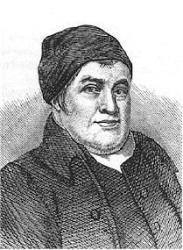Scripture References:
st. 1-3 = Gal. 3:28
st. 3 = Gal. 6:2
An orphan at the age of twelve, John Fawcett (b. Lidget Green, Yorkshire, England, 1740; d. Hebden Bridge, Yorkshire, 1817) became apprenticed to a tailor and was largely self-educated. He was converted by the preaching of George Whitefield at the age of sixteen and began preaching soon thereafter. In 1765 Fawcett was called to a small, poor, Baptist country church in Wainsgate, Yorkshire. Seven years later he received a call from the large and influential Carter's Lane Church in London, England. Fawcett accepted the call and preached his farewell sermon. The day of departure came, and his family's belongings were loaded on carts, but the distraught congregation begged him to stay. In Singers and Songs of the Church (1869), Josiah Miller tells the story associated with this text:
This favorite hymn is said to have been written in 1772, to commemorate the determination of its author to remain with his attached people at Wainsgate. The farewell sermon was preached, the wagons were loaded, when love and tears prevailed, and Dr. Fawcett sacrificed the attraction of a London pulpit to the affection of his poor but devoted flock.
Fawcett continued to serve in Wainsgate and in the nearby village of Hebden Bridge for the remainder of his active ministry.
Fawcett titled this hymn "Brotherly Love." It is essentially about the communion of saints, bound together in love (st. 1), united in worship (st. 2), sharing each other's burdens (st. 3), and encouraging each other with the hope of eternal life in glory, where will be reunited with departed friends and freed "from sorrow, toil, and pain and sin (st. 4-6).
He wrote most of his hymns to be sung by his congregation at the conclusion of the sermon. They were published in Hymns adapted to the Circumstances of Public Worship and Private Devotion (1782). In the preface to his collection Fawcett apologized to "persons of an elevated genius" for his "plain verses" but expressed the hope that they would edify "humble Christians."
Liturgical Use:
Worship services that stress unity or the communion of saints; occasions of departure; encouragement for mutual prayer, fellowship, and burden bearing; close of the worship service or other church meetings; funerals.
--Psalter Hymnal Handbook
========================
Blest be [is] the tie that binds. J. Fawcett. [Brotherly Love.] Miller, in his Singers and Songs of the Church, 1869, p. 273, says:—
"This favourite hymn is said to have been written in I772, to commemorate the determination of its author to remain with his attached people at Wainsgate. The farewell sermon was preached, the waggons were loaded, when love and tears prevailed, and Dr. Fawcett sacrificed the attractions of a London pulpit to the affection of his poor but devoted flock."
Three sources of information on the matter are, however, silent on the subject—his Life and Letters, 1818; his Misc. Writings, 1826; and his Funeral Sermon. Failing direct evidence, the most that can be said is that internal evidence in the hymn itself lends countenance to the statement that it was composed under the circumstances given above. Its certain history begins with its publication in Fawcett's Hymns, &c, 1782, No. 104, where it is given in 6 stanzas of 4 lines From an early date it has been in common use, especially with the Nonconformists, and at the present time it is found in a greater number of collections in Great Britain and America than almost any other hymn by Fawcett. It is usually given as “Blest is the tie," &c, and in an abridged form. Original text in Spurgeon's Our Own Hymn Book, 1866, No. 892, and Songs for the Sanctuary, N. Y., 1865, No. 847.
-- John Julian, Dictionary of Hymnology (1907)


 My Starred Hymns
My Starred Hymns








